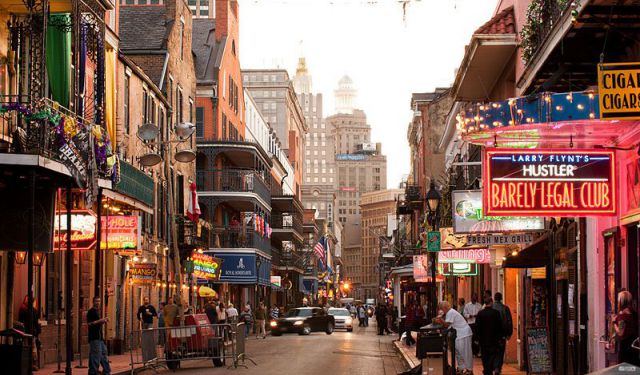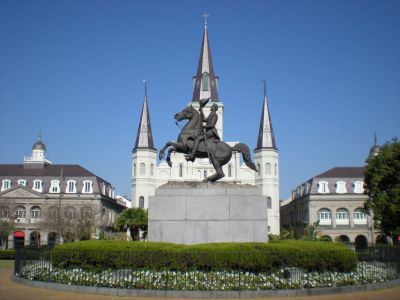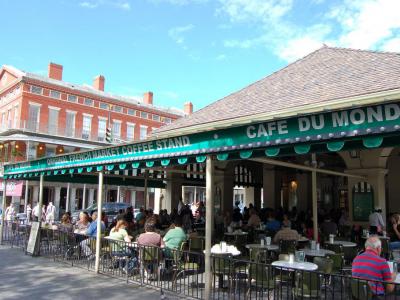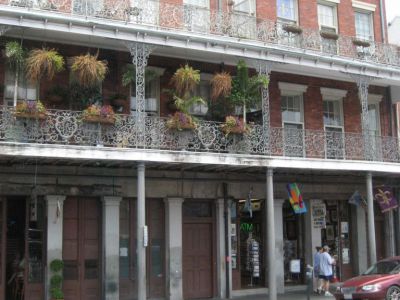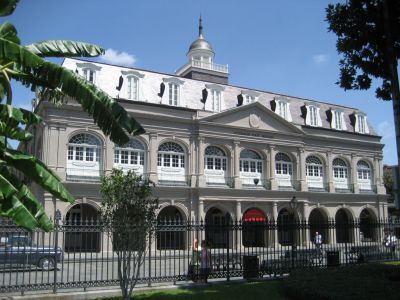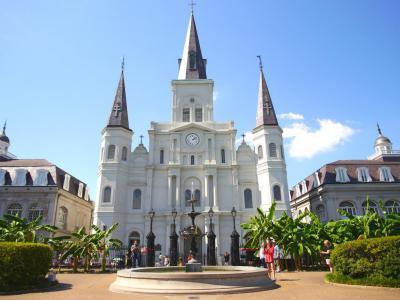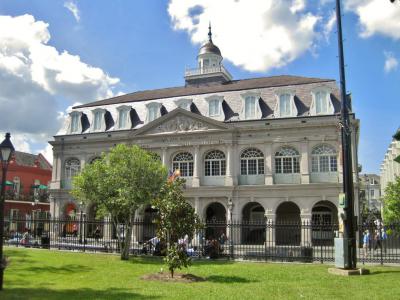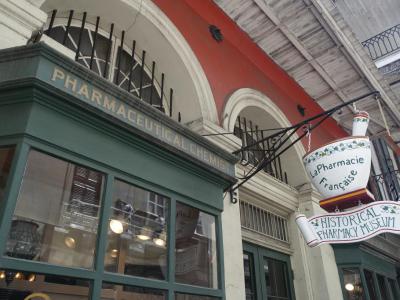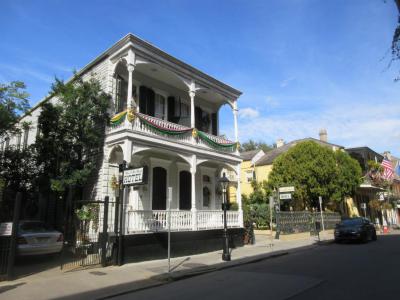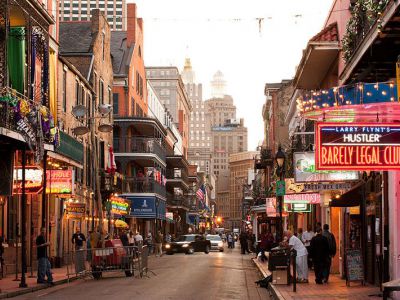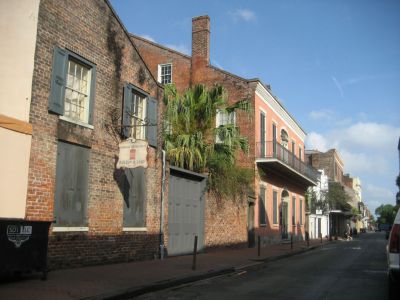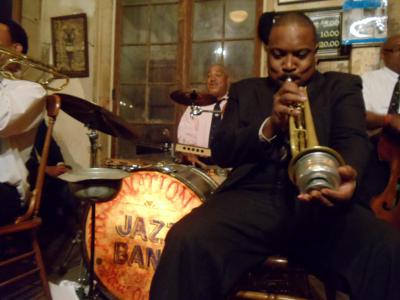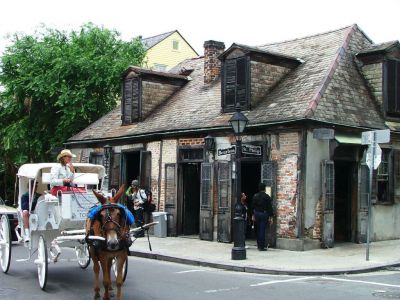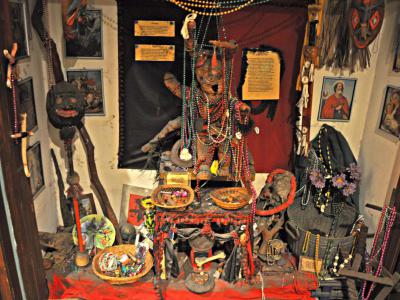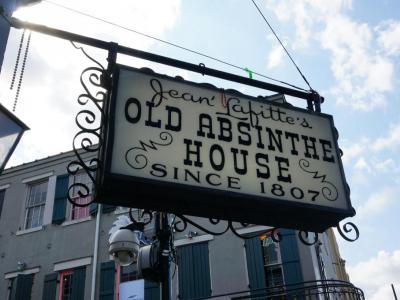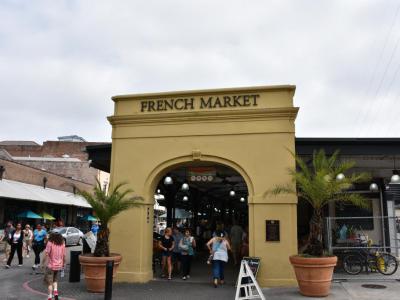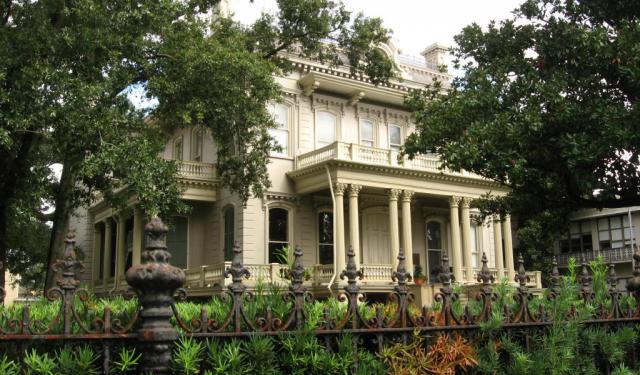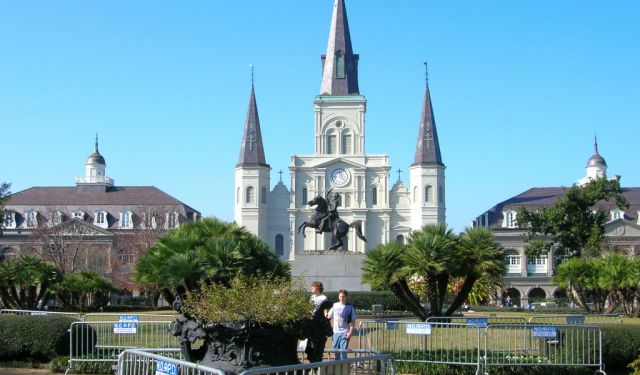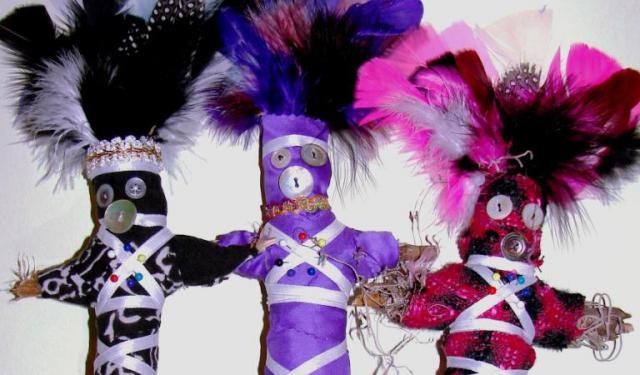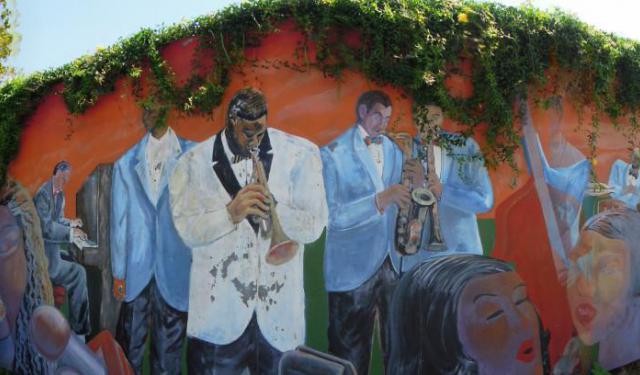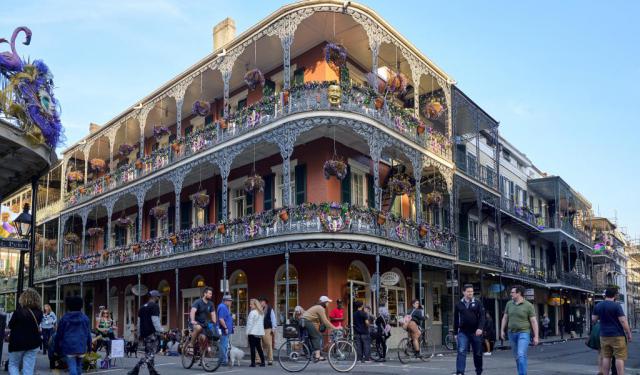Audio Guide: French Quarter Walking Tour (Self Guided), New Orleans
The French Quarter, also known as the Old Square, is New Orleans' oldest and most popular neighborhood. Founded in 1718, it perfectly combines the tempting, noisy and nutty nightlife of Bourbon Street with important historical landmarks, art galleries, sophisticated cafés, and some of the city's oldest churches – all within walking distance, close to Mississippi River.
On this self-guided walking tour, the French Quarter will be brought to life with stories, legends, interesting facts and experiences involving the architecture, courtyards, food, beverages, music, art and gardens that all lend to its distinct character.
You must see Jackson Square, the Pontalba buildings with their shops & restaurants, and admire the St. Louis Cathedral’s gothic majesty - either from ground-level or the top of the Cabildo. Close-by is the famed Cafe du Monde for coffee and beignets.
Yes while the jazz or zydeco music pouring out of every doorway is fun to experience, Bourbon Street can be a bit much for some, but it also has many fine restaurants, lovely Creole houses and beautiful balconies framed in wrought iron. Meanwhile, Royal Street offers countless upscale galleries, boutiques, eateries, and local flavor.
On the last stretch, don’t miss the sight of numerous historic houses and go to Preservation Hall to catch an authentic old-style jazz concert. End in style with the French Market – a huge walkable place with plenty to see and choose from.
These are just a few things that draw people to the French Quarter year after year, so take this self-guided walking tour to find your way around and make the most of your time in New Orleans.
On this self-guided walking tour, the French Quarter will be brought to life with stories, legends, interesting facts and experiences involving the architecture, courtyards, food, beverages, music, art and gardens that all lend to its distinct character.
You must see Jackson Square, the Pontalba buildings with their shops & restaurants, and admire the St. Louis Cathedral’s gothic majesty - either from ground-level or the top of the Cabildo. Close-by is the famed Cafe du Monde for coffee and beignets.
Yes while the jazz or zydeco music pouring out of every doorway is fun to experience, Bourbon Street can be a bit much for some, but it also has many fine restaurants, lovely Creole houses and beautiful balconies framed in wrought iron. Meanwhile, Royal Street offers countless upscale galleries, boutiques, eateries, and local flavor.
On the last stretch, don’t miss the sight of numerous historic houses and go to Preservation Hall to catch an authentic old-style jazz concert. End in style with the French Market – a huge walkable place with plenty to see and choose from.
These are just a few things that draw people to the French Quarter year after year, so take this self-guided walking tour to find your way around and make the most of your time in New Orleans.
How it works: Download the app "GPSmyCity: Walks in 1K+ Cities" from Apple App Store or Google Play Store to your mobile phone or tablet. The app turns your mobile device into a personal tour guide and its built-in GPS navigation functions guide you from one tour stop to next. The app works offline, so no data plan is needed when traveling abroad.
French Quarter Walking Tour Map
Guide Name: French Quarter Walking Tour
Guide Location: USA » New Orleans (See other walking tours in New Orleans)
Guide Type: Self-guided Walking Tour (Sightseeing)
# of Attractions: 15
Tour Duration: 2 Hour(s)
Travel Distance: 3.4 Km or 2.1 Miles
Author: DanaOffice
Sight(s) Featured in This Guide:
Guide Location: USA » New Orleans (See other walking tours in New Orleans)
Guide Type: Self-guided Walking Tour (Sightseeing)
# of Attractions: 15
Tour Duration: 2 Hour(s)
Travel Distance: 3.4 Km or 2.1 Miles
Author: DanaOffice
Sight(s) Featured in This Guide:
- Jackson Square
- Cafe du Monde
- 1850 House
- The Presbytere
- St. Louis Cathedral
- The Cabildo
- Pharmacy Museum
- Royal Street
- Bourbon Street
- Hermann-Grima House
- Preservation Hall
- Lafitte's Blacksmith Shop Bar
- Historic Voodoo Museum
- Old Absinthe House
- French Market
1) Jackson Square (must see)
Due to its close proximity to the Mississippi River, the Saint Louis Cathedral, and the Cabildo, Jackson Square has always been and remains a well-liked gathering place at the heart of the French Quarter. Named after Andrew Jackson, hero of the Battle of New Orleans (who went on to become the 7th US president), it has been a hubbub of activity since colonial times, when the militia conducted drills, vendors peddled their goods at the open-air market, and public executions were carried out.
Modeled after the famous 17th-century Place des Vosges in Paris, the square has been transformed into a beautifully landscaped park with neat lawns and flowerbeds. Despite the constant flow of tourists taking photos, school groups, and waitstaff on their breaks, it somehow maintains a sense of tranquility. During the day, numerous artists display their paintings on the park's fence and set up outdoor studios where they create artworks or offer to sketch portraits of passersby. Musicians, mimes, tarot card readers, and magicians entertain on the paved pedestrian mall, many of them performing both day and night.
The view of the square is quite iconic, with an equestrian statue of Andrew Jackson at its center and the beautifully designed Saint Louis Cathedral as a backdrop, while the Cabildo and Presbytère, two Spanish colonial structures, flank the church. The elegant brick buildings on either side of the square are known as the Pontalba Buildings. All in all, an excellent spot for capturing memorable photos, enjoying a respite on the benches, and taking it all in. It's amazing how much of New Orleans can be experienced from just this small location.
Modeled after the famous 17th-century Place des Vosges in Paris, the square has been transformed into a beautifully landscaped park with neat lawns and flowerbeds. Despite the constant flow of tourists taking photos, school groups, and waitstaff on their breaks, it somehow maintains a sense of tranquility. During the day, numerous artists display their paintings on the park's fence and set up outdoor studios where they create artworks or offer to sketch portraits of passersby. Musicians, mimes, tarot card readers, and magicians entertain on the paved pedestrian mall, many of them performing both day and night.
The view of the square is quite iconic, with an equestrian statue of Andrew Jackson at its center and the beautifully designed Saint Louis Cathedral as a backdrop, while the Cabildo and Presbytère, two Spanish colonial structures, flank the church. The elegant brick buildings on either side of the square are known as the Pontalba Buildings. All in all, an excellent spot for capturing memorable photos, enjoying a respite on the benches, and taking it all in. It's amazing how much of New Orleans can be experienced from just this small location.
2) Cafe du Monde (must see)
Open around the clock, the open-air Café du Monde (French for "Café of the World" or "the People's Café") holds a special place in the heart of New Orleans. Established in the 1860s, it has gained fame for its uniquely flavored café au lait (coffee with added hot milk) paired with the warm, sugar-dusted beignets. It’s the perfect spot to unwind at a table while enjoying the melodies of street musicians.
Coffee was introduced by the French settlers who began inhabiting the Gulf Coast and the Mississippi River region around 1700. During the American Civil War, due to a coffee shortage, New Orleans Creoles devised a blend of coffee and chicory, imparting a chocolate-like flavor to the café au lait. This version has since become a signature offering at Café du Monde and other New Orleans eateries.
In the 18th century, French settlers from Nova Scotia brought various traditions to Louisiana, including the beloved beignet. Unlike most doughnuts, these are square pieces of dough without a central hole, served with toppings like fruit, jam, maple syrup, or even savory fillings. At Café du Monde, the fried delights are served warm, generously dusted with powdered sugar and come in orders of three.
The café draws a diverse crowd, including late-night revelers, socialites, students, locals, tourists, and people from all corners of the globe, resulting in a lively atmosphere filled with a multitude of accents.
Tips:
Keep in mind that the café operates on a cash-only basis. If you find it too crowded, consider going around to the take-out window in the back and enjoying your treats along the picturesque Mississippi riverfront.
Coffee was introduced by the French settlers who began inhabiting the Gulf Coast and the Mississippi River region around 1700. During the American Civil War, due to a coffee shortage, New Orleans Creoles devised a blend of coffee and chicory, imparting a chocolate-like flavor to the café au lait. This version has since become a signature offering at Café du Monde and other New Orleans eateries.
In the 18th century, French settlers from Nova Scotia brought various traditions to Louisiana, including the beloved beignet. Unlike most doughnuts, these are square pieces of dough without a central hole, served with toppings like fruit, jam, maple syrup, or even savory fillings. At Café du Monde, the fried delights are served warm, generously dusted with powdered sugar and come in orders of three.
The café draws a diverse crowd, including late-night revelers, socialites, students, locals, tourists, and people from all corners of the globe, resulting in a lively atmosphere filled with a multitude of accents.
Tips:
Keep in mind that the café operates on a cash-only basis. If you find it too crowded, consider going around to the take-out window in the back and enjoying your treats along the picturesque Mississippi riverfront.
3) 1850 House
The 1850 House is a meticulously preserved townhouse, complete with a courtyard that provides rare public access to the interior of the Pontalba Buildings beyond their storefronts. These buildings were commissioned by the wealthy Baroness de Pontalba in 1849, during a period when New Orleans was one of the largest cities in the United States, fueled by the prosperity of its thriving port.
Inspired by the imposing Parisian architecture the Baroness favored, the distinctive row houses were intended to serve as both elegant residences and fine retail establishments. Each building contained shops on the ground floors and sixteen separate apartments on the upper floors. The latter were considered the pinnacle of style among the prosperous middle class, particularly for their ornate iron balconies, admired as much today as they were in antebellum times.
The three-story residence, now run by the Louisiana State Museum, provides a glimpse into the life of a well-to-do family in the 1850s; a time considered the height of Southern prosperity. Faithfully furnished with domestic items, decorative arts, and innovations of the day (including walk-in closets), the interior displays several artworks and furniture inspired by Rococo, Gothic, and Classical styles.
The 1850 House does not depict a specific family as its residents were transient tenants, typically staying for only a few years. Instead, it offers a glimpse into the affluence, preferences, and daily life of mid-nineteenth-century life in New Orleans.
Tip:
Take time to visit the downstairs store run by the Friends of the Cabildo, where you can find handmade art, jewelry, pottery, and crafts by local artists, as well as an array of books on every local subject – from New Orleans history to food and even voodoo.
Inspired by the imposing Parisian architecture the Baroness favored, the distinctive row houses were intended to serve as both elegant residences and fine retail establishments. Each building contained shops on the ground floors and sixteen separate apartments on the upper floors. The latter were considered the pinnacle of style among the prosperous middle class, particularly for their ornate iron balconies, admired as much today as they were in antebellum times.
The three-story residence, now run by the Louisiana State Museum, provides a glimpse into the life of a well-to-do family in the 1850s; a time considered the height of Southern prosperity. Faithfully furnished with domestic items, decorative arts, and innovations of the day (including walk-in closets), the interior displays several artworks and furniture inspired by Rococo, Gothic, and Classical styles.
The 1850 House does not depict a specific family as its residents were transient tenants, typically staying for only a few years. Instead, it offers a glimpse into the affluence, preferences, and daily life of mid-nineteenth-century life in New Orleans.
Tip:
Take time to visit the downstairs store run by the Friends of the Cabildo, where you can find handmade art, jewelry, pottery, and crafts by local artists, as well as an array of books on every local subject – from New Orleans history to food and even voodoo.
4) The Presbytere
Constructed in 1797 originally as a residence for the clergy of the Saint Louis Cathedral, the two-story Presbytère on Jackson Square shares a structural resemblance with the Cabildo and stands as one of the nation's finest examples of formal Spanish Colonial architecture. Despite the rich array of Renaissance elements, it never served its intended purpose, as its financial backer, a wealthy Spaniard, passed away before its completion. Eventually, the newly formed U.S. government took charge of finishing the building and repurposed it to house the Louisiana state courts during the 19th century.
In 1911, the Presbytère became part of the Louisiana State Museum, and today, it hosts a vibrant permanent exhibit dedicated to the history of Mardi Gras traditions, both in the city of New Orleans and the state of Louisiana. The display delves into many lesser-known aspects of the celebration and is presented in a compelling and poignant manner, relying on first-person accounts, photographs, audio recordings, videos, and beautiful artifacts such as crowns, scepters, costumes, and accessories associated with the annual festivities, which have grown to become one of the most renowned festivals globally.
On the first floor, visitors will find the "Living with Hurricanes: Katrina and Beyond", a similarly poignant yet uplifting exploration of the history, science, and profound human experiences associated with one of nature's most devastating forces. The well-narrated presentation and visual depictions provide an immersive understanding of the events and the resilience of the people of New Orleans in the face of the Katrina disaster, making you feel as if you were part of that challenging period in the city's history.
Tip:
Consider buying a combo ticket that offers a 20% discount when visiting along with The Cabildo on the Cathedral's other side (or any other Louisiana State Museum site).
In 1911, the Presbytère became part of the Louisiana State Museum, and today, it hosts a vibrant permanent exhibit dedicated to the history of Mardi Gras traditions, both in the city of New Orleans and the state of Louisiana. The display delves into many lesser-known aspects of the celebration and is presented in a compelling and poignant manner, relying on first-person accounts, photographs, audio recordings, videos, and beautiful artifacts such as crowns, scepters, costumes, and accessories associated with the annual festivities, which have grown to become one of the most renowned festivals globally.
On the first floor, visitors will find the "Living with Hurricanes: Katrina and Beyond", a similarly poignant yet uplifting exploration of the history, science, and profound human experiences associated with one of nature's most devastating forces. The well-narrated presentation and visual depictions provide an immersive understanding of the events and the resilience of the people of New Orleans in the face of the Katrina disaster, making you feel as if you were part of that challenging period in the city's history.
Tip:
Consider buying a combo ticket that offers a 20% discount when visiting along with The Cabildo on the Cathedral's other side (or any other Louisiana State Museum site).
5) St. Louis Cathedral (must see)
Saint Louis Cathedral's triple spires are instantly recognizable to most tourists as the main symbol of the French Quarter. Many have taken photos of the gleaming white facade set against a clear blue sky from across the picturesque Jackson Square; however, relatively few have ventured inside to witness the glorious mural and statuary, transporting visitors nearly 300 years back in time to the cathedral's founding. Along the first floor, stained glass windows depict the life of King Louis IX, the French monarch who led two crusades.
Saint Louis proudly holds the title of the oldest continuously active Roman Catholic Cathedral in the United States. The existing structure, which replaced two previous buildings destroyed by fires, dates back to 1794, though it underwent remodeling and expansion in 1851. The influences of both Spanish and French cultures are readily apparent in both the artwork and the flags displayed near the chandeliers in the main aisle of the sanctuary.
Notably, Pope John Paul II conducted a prayer service for clergy here during his visit to New Orleans in 1987; in commemoration of the event, the nearby pedestrian mall was renamed in his honor. Of particular interest is his portrait in a Jackson Square setting, displayed on the cathedral's inner sidewall.
Visitors can often enjoy free tours conducted by docents, or they can opt for a self-guided tour using brochures when there are no church events taking place. A fine pipe organ is frequently played for the delight of guests, and there is also a small gift shop to explore.
Tip:
Take note of the sloping floor, a clever architectural design that somehow manages to keep the building upright even as the ground beneath it continues to sink.
Saint Louis proudly holds the title of the oldest continuously active Roman Catholic Cathedral in the United States. The existing structure, which replaced two previous buildings destroyed by fires, dates back to 1794, though it underwent remodeling and expansion in 1851. The influences of both Spanish and French cultures are readily apparent in both the artwork and the flags displayed near the chandeliers in the main aisle of the sanctuary.
Notably, Pope John Paul II conducted a prayer service for clergy here during his visit to New Orleans in 1987; in commemoration of the event, the nearby pedestrian mall was renamed in his honor. Of particular interest is his portrait in a Jackson Square setting, displayed on the cathedral's inner sidewall.
Visitors can often enjoy free tours conducted by docents, or they can opt for a self-guided tour using brochures when there are no church events taking place. A fine pipe organ is frequently played for the delight of guests, and there is also a small gift shop to explore.
Tip:
Take note of the sloping floor, a clever architectural design that somehow manages to keep the building upright even as the ground beneath it continues to sink.
6) The Cabildo
Erected in 1795 by the Spanish colonial government, The Cabildo witnessed some of the most pivotal events in American history, including the ceremonies for the Louisiana Purchase transfer, a momentous transaction that nearly doubled the size of the United States in 1803. Sitting on the opposite side of the Saint Louis Cathedral from The Presbytère, this landmark once functioned as the colonial government's headquarters and later housed the Louisiana Supreme Court.
The building's architecture is a testament to the Spanish influence on New Orleans, with its intricate ironwork balconies and distinctive Spanish flair, which contrast with the French colonial styles prevalent in the city.
Today, The Cabildo is a museum housing a premier collection of artifacts related to New Orleans and Louisiana history – spanning from the earliest explorers to encompass themes such as slavery, post-Civil War reconstruction, and statehood. The detailed narrative is presented from a multicultural perspective and touches on intriguing subjects like immigration, assimilation, antebellum music, mourning and burial customs, and the role of Southern women.
Throughout the museum, one can find portraits of historical figures and pivotal events. A standout exhibit is Napoleon's death mask made by Napoleon's personal physician shortly after the French leader's death in 1821 on the island of Saint Helena, where he was in exile.
Overall, an ideal place to explore the history of New Orleans and Louisiana. As an extra, the upstairs offers great views of Jackson Square.
Tip:
Consider buying a combo ticket that offers a 20% discount when visiting along with The Presbytère on the Cathedral's other side (or any other Louisiana State Museum site).
The building's architecture is a testament to the Spanish influence on New Orleans, with its intricate ironwork balconies and distinctive Spanish flair, which contrast with the French colonial styles prevalent in the city.
Today, The Cabildo is a museum housing a premier collection of artifacts related to New Orleans and Louisiana history – spanning from the earliest explorers to encompass themes such as slavery, post-Civil War reconstruction, and statehood. The detailed narrative is presented from a multicultural perspective and touches on intriguing subjects like immigration, assimilation, antebellum music, mourning and burial customs, and the role of Southern women.
Throughout the museum, one can find portraits of historical figures and pivotal events. A standout exhibit is Napoleon's death mask made by Napoleon's personal physician shortly after the French leader's death in 1821 on the island of Saint Helena, where he was in exile.
Overall, an ideal place to explore the history of New Orleans and Louisiana. As an extra, the upstairs offers great views of Jackson Square.
Tip:
Consider buying a combo ticket that offers a 20% discount when visiting along with The Presbytère on the Cathedral's other side (or any other Louisiana State Museum site).
7) Pharmacy Museum
What a find this museum is! It offers a well-rounded experience combining education, spookiness, a picture-perfect garden setting, and even a charming balcony. Whether you opt for a guided tour or prefer to explore at your own pace, you'll journey through the nation's first pharmacy, which weaves together the stories of its owners, including J. Dufilho, recognized as the first licensed pharmacist in the U.S. Along the way, you'll also delve into the intriguing tales of supposed hauntings that have been associated with the building.
The museum spans two floors, with the initial creaky wooden level faithfully replicating a functioning apothecary that includes a soda fountain from 1855. Here, you'll encounter displays featuring blood-letting equipment, microscopes, and 19th-century cosmetics elegantly housed in rosewood cabinets. At the prescription counter, you can gain insights into how pharmacists of the era prepared and filled vintage bottles with a wide range of substances, from voodoo potions and herbs to opium and cocaine-based medications.
Ascending to the second floor, you'll find an examination room replete with a hospital bed and an array of antiquated surgical instruments, including archaic child-birthing devices, vintage wheelchairs, primitive crutches, inhalers, and spectacles.
In the tranquil courtyard tucked behind the apothecary, away from the busy street, you'll encounter a variety of herbs and flowers that were once integral to the pharmacy trade. These plants served diverse medicinal purposes: Aloe was applied to soothe burns, jasmine was used to calm upset stomachs, foxglove acted as a potent heart stimulant, and Angel’s Trumpet offered relief from asthma symptoms.
All in all, a visit to the Pharmacy Museum is a rewarding investment of both your money and time.
The museum spans two floors, with the initial creaky wooden level faithfully replicating a functioning apothecary that includes a soda fountain from 1855. Here, you'll encounter displays featuring blood-letting equipment, microscopes, and 19th-century cosmetics elegantly housed in rosewood cabinets. At the prescription counter, you can gain insights into how pharmacists of the era prepared and filled vintage bottles with a wide range of substances, from voodoo potions and herbs to opium and cocaine-based medications.
Ascending to the second floor, you'll find an examination room replete with a hospital bed and an array of antiquated surgical instruments, including archaic child-birthing devices, vintage wheelchairs, primitive crutches, inhalers, and spectacles.
In the tranquil courtyard tucked behind the apothecary, away from the busy street, you'll encounter a variety of herbs and flowers that were once integral to the pharmacy trade. These plants served diverse medicinal purposes: Aloe was applied to soothe burns, jasmine was used to calm upset stomachs, foxglove acted as a potent heart stimulant, and Angel’s Trumpet offered relief from asthma symptoms.
All in all, a visit to the Pharmacy Museum is a rewarding investment of both your money and time.
8) Royal Street (must see)
If you're seeking a taste of the finer things in life, look no further than one of New Orleans' most exquisite streets. In stark contrast to the nearby Bourbon Street, this thoroughfare exudes a more sedate culture and refinement, offering a plethora of upscale galleries, boutiques, dining establishments, and charming local touches, such as potted ferns hanging from balcony railings. As one of the city's oldest arteries, it's a place where you can indulge in some fantastic people-watching while having easy access to all the major attractions.
Lining this street, you'll find an array of 18th- and 19th-century buildings, each with their ornate and beautiful designs, showcasing first-class selections of antiques and artworks that rival those exhibited in prominent museums. Make sure to explore the sublime collection at the historic M.S. Rau store at 630 Royal, which welcomes casual observers. Other notable stores specialize in jewelry and decorative carnival masks, ranging from simple feather-and-ceramic styles to handcrafted, locally-made varieties with heftier price tags.
Royal Street is so unique that you may find it challenging to decide where to begin and where to end your exploration. Whether you choose to visit the Gallier House, explore the Historic New Orleans Collection, or dine at restaurants adorned with scenic gardens, ornate fountains, and beautiful courtyards, there's an abundance to see and do here.
Why You Should Visit:
A refreshing escape from NOLA's bustling bar and party scene, as the vibe here is more family-friendly, and the shops have many souvenirs appropriate for family and friends, particularly as you approach the highly trafficked areas near the river. Several blocks are closed to vehicles between 11 am to 4 pm, creating a pedestrian-friendly space where colorful street performers entertain and engage with visitors in exchange for tips.
Lining this street, you'll find an array of 18th- and 19th-century buildings, each with their ornate and beautiful designs, showcasing first-class selections of antiques and artworks that rival those exhibited in prominent museums. Make sure to explore the sublime collection at the historic M.S. Rau store at 630 Royal, which welcomes casual observers. Other notable stores specialize in jewelry and decorative carnival masks, ranging from simple feather-and-ceramic styles to handcrafted, locally-made varieties with heftier price tags.
Royal Street is so unique that you may find it challenging to decide where to begin and where to end your exploration. Whether you choose to visit the Gallier House, explore the Historic New Orleans Collection, or dine at restaurants adorned with scenic gardens, ornate fountains, and beautiful courtyards, there's an abundance to see and do here.
Why You Should Visit:
A refreshing escape from NOLA's bustling bar and party scene, as the vibe here is more family-friendly, and the shops have many souvenirs appropriate for family and friends, particularly as you approach the highly trafficked areas near the river. Several blocks are closed to vehicles between 11 am to 4 pm, creating a pedestrian-friendly space where colorful street performers entertain and engage with visitors in exchange for tips.
9) Bourbon Street (must see)
If you're feeling adventurous, set aside your reservations and take a leisurely stroll down the infamous Bourbon Street, known for its vibrant mix of bars, restaurants, music clubs, adult stores, and novelty shops, earning its reputation as the playground of the South. In the aftermath of Hurricane Katrina, the bars of Bourbon Street were among the first businesses in the city to reopen, and they played a crucial role in revitalizing the area. Today, the spirit of unbridled revelry thrives here, with raucous crowds and a lively jazz scene.
However, this street is not just about partying; it also boasts historic sights and iconic venues. Here you will find some of the city's most luxurious spots, including the timeless Royal Sonesta Hotel and the Galatoire's fine-dining institution, where you can savor the best of French Creole cuisine in a festive yet elegant atmosphere (note that jackets are required).
Among the iconic bars on Bourbon Street, Lafitte's Blacksmith Shop on the corner of Saint Philip Street stands out, as does the Old Absinthe House – the birthplace of the famous Absinthe House Frappe. You'll also find the Lafitte in Exile, the oldest gay bar in the United States, where famed American playwrights Tennessee Williams and Truman Capote were regular patrons. For those with a penchant for jazz, head to Fritzel's European Jazz Pub, an almost 200-year-old building that hosts live jazz performances every night of the week.
Why You Should Visit:
During the day, the street offers a pleasant experience with its art shops and food options; however, when night falls, it transforms into a wild and vibrant place. Be prepared for sensory overload, with the bright lights, loud music, and various scents permeating the air. This street has a knack for surprising even the most unflappable visitors.
Tip:
Don't miss the famous hand grenade drink! Also, be mindful not to take pictures of street performers if you don't intend to tip them.
However, this street is not just about partying; it also boasts historic sights and iconic venues. Here you will find some of the city's most luxurious spots, including the timeless Royal Sonesta Hotel and the Galatoire's fine-dining institution, where you can savor the best of French Creole cuisine in a festive yet elegant atmosphere (note that jackets are required).
Among the iconic bars on Bourbon Street, Lafitte's Blacksmith Shop on the corner of Saint Philip Street stands out, as does the Old Absinthe House – the birthplace of the famous Absinthe House Frappe. You'll also find the Lafitte in Exile, the oldest gay bar in the United States, where famed American playwrights Tennessee Williams and Truman Capote were regular patrons. For those with a penchant for jazz, head to Fritzel's European Jazz Pub, an almost 200-year-old building that hosts live jazz performances every night of the week.
Why You Should Visit:
During the day, the street offers a pleasant experience with its art shops and food options; however, when night falls, it transforms into a wild and vibrant place. Be prepared for sensory overload, with the bright lights, loud music, and various scents permeating the air. This street has a knack for surprising even the most unflappable visitors.
Tip:
Don't miss the famous hand grenade drink! Also, be mindful not to take pictures of street performers if you don't intend to tip them.
10) Hermann-Grima House
A historic treasure nestled in the heart of the French Quarter, the Hermann-Grima House exudes the charm and elegance of the antebellum era. Its significance lies not only in its Federal-style architecture, which stands out among the predominantly Creole buildings of the quarter but also in its well-documented history of the city's social and domestic life.
Constructed in 1831 for Samuel Hermann, a German-Jewish immigrant who married into a prosperous French-Creole family, this stately mansion reflects the affluence and style of New Orleans' 19th-century mercantile elite. Featuring a charming bricked courtyard, the French Quarter's only surviving stable, and a fully functional outdoor kitchen from the 1830s, it is noted for its intact features, including the elaborate carriageways and preserved interior, which boasts period furnishings and intricate decor.
Now a museum, the house regularly hosts historically accurate special exhibitions, including presentations for holidays, displays of summer dresses, and a slightly spooky atmosphere in October. Additionally, by retaining your receipt, you can enjoy a discounted visit to the nearby Gallier House, interesting in its own right for the lovely period furniture, rotating exhibitions, and overall design.
Tip:
Don't miss a visit from October through May, as this is when cooking demonstrations take place in the open hearth of the Creole kitchen, using tools and techniques from the 19th century. Otherwise, be sure to explore the gift shop for a wealth of local crafts and books.
Constructed in 1831 for Samuel Hermann, a German-Jewish immigrant who married into a prosperous French-Creole family, this stately mansion reflects the affluence and style of New Orleans' 19th-century mercantile elite. Featuring a charming bricked courtyard, the French Quarter's only surviving stable, and a fully functional outdoor kitchen from the 1830s, it is noted for its intact features, including the elaborate carriageways and preserved interior, which boasts period furnishings and intricate decor.
Now a museum, the house regularly hosts historically accurate special exhibitions, including presentations for holidays, displays of summer dresses, and a slightly spooky atmosphere in October. Additionally, by retaining your receipt, you can enjoy a discounted visit to the nearby Gallier House, interesting in its own right for the lovely period furniture, rotating exhibitions, and overall design.
Tip:
Don't miss a visit from October through May, as this is when cooking demonstrations take place in the open hearth of the Creole kitchen, using tools and techniques from the 19th century. Otherwise, be sure to explore the gift shop for a wealth of local crafts and books.
11) Preservation Hall (must see)
Just a short stroll from the banks of the Mississippi River, nestled in the heart of the renowned French Quarter, the aptly named Preservation Hall is a true cultural landmark. Much of its charm lies in its rustic, intimate, old-school atmosphere: weathered walls with paintings of local musicians, bench seating, a strict no-phone policy, and a commitment to preserving the essence of New Orleans jazz through authentic means, such as eschewing amplifiers and a bar.
The focus here is on keeping New Orleans jazz vibrant and alive, though, in recent years, the house band has expanded its horizons by collaborating on tours and recordings with artists from various genres, including gospel, hip hop, rock, and other inventive blends. The venue features a roster of seasoned musicians, as well as a few younger talents, all delivering outstanding performances.
Seating is limited, often leading many patrons to settle on the floor or stand at the back. While beverages are not served within the hall, you are welcome to bring your own drink in a plastic cup. Despite these limitations, countless music enthusiasts consider an evening at this all-ages venue an essential and quintessential New Orleans experience.
Tip:
To ensure you secure a spot, plan to arrive 45-60 minutes before one of the daily shows at 5, 6, 8, 9, and 10 pm; alternatively, you can opt for a "Big Shot" ticket, which guarantees you a seat and allows you to skip the line. The good news is that this venue stands just around the corner from Pat O'Brien's, where you can enjoy a hurricane cocktail to go while you wait.
The focus here is on keeping New Orleans jazz vibrant and alive, though, in recent years, the house band has expanded its horizons by collaborating on tours and recordings with artists from various genres, including gospel, hip hop, rock, and other inventive blends. The venue features a roster of seasoned musicians, as well as a few younger talents, all delivering outstanding performances.
Seating is limited, often leading many patrons to settle on the floor or stand at the back. While beverages are not served within the hall, you are welcome to bring your own drink in a plastic cup. Despite these limitations, countless music enthusiasts consider an evening at this all-ages venue an essential and quintessential New Orleans experience.
Tip:
To ensure you secure a spot, plan to arrive 45-60 minutes before one of the daily shows at 5, 6, 8, 9, and 10 pm; alternatively, you can opt for a "Big Shot" ticket, which guarantees you a seat and allows you to skip the line. The good news is that this venue stands just around the corner from Pat O'Brien's, where you can enjoy a hurricane cocktail to go while you wait.
12) Lafitte's Blacksmith Shop Bar (must see)
Lafitte's Blacksmith Shop Bar on Bourbon Street is one of the city's most storied landmarks, a tangible piece of history that doubles as a popular watering hole. Touted as one of the oldest surviving structures in New Orleans and reputed to be the oldest continuously operating bar in the United States, this building harks back to the early 18th century. The bar's namesake, Jean Lafitte, was a pirate and privateer who, along with his brother Pierre, purportedly used the location as a cover for their smuggling operations.
Constructed sometime between 1722 and 1732, the building is a rare example of French Colonial "briquette-entre-poteaux" architecture (brick between posts), surviving fires and battles that have reshaped the city over centuries. Its thick-walled, weather-beaten façade and dimly lit interior, with a fireplace and candlelight providing much of the illumination, offer an ambiance that seemingly transports patrons back to the era of pirates and privateers.
Frequented by locals and tourists alike, Lafitte's combines the allure of historical legend with the charm of Old New Orleans. The bar, aside from its drinks and unique atmosphere, is an informal museum of sorts, with its architecture and mystique speaking volumes of the past. It is this blending of lore and architecture, the promise of ghosts, and the glow of flickering lights that make Lafitte's a must-visit destination for anyone looking to experience the essence of the Crescent City's storied past.
Constructed sometime between 1722 and 1732, the building is a rare example of French Colonial "briquette-entre-poteaux" architecture (brick between posts), surviving fires and battles that have reshaped the city over centuries. Its thick-walled, weather-beaten façade and dimly lit interior, with a fireplace and candlelight providing much of the illumination, offer an ambiance that seemingly transports patrons back to the era of pirates and privateers.
Frequented by locals and tourists alike, Lafitte's combines the allure of historical legend with the charm of Old New Orleans. The bar, aside from its drinks and unique atmosphere, is an informal museum of sorts, with its architecture and mystique speaking volumes of the past. It is this blending of lore and architecture, the promise of ghosts, and the glow of flickering lights that make Lafitte's a must-visit destination for anyone looking to experience the essence of the Crescent City's storied past.
13) Historic Voodoo Museum
Founded in 1972, this homegrown museum is a place that might make even skeptics reconsider their views. In New Orleans, Voodoo isn't just a tourist attraction; it remains an integral part of many locals' lives. People still light candles for good luck and turn to potions to find love. Inside, you will find an extensive collection of artifacts, including portraits of Voodoo legends, African items believed to have influenced the development of the religion, and a wealth of gris-gris.
Visitors can also have a personal psychic reading with the local priestess, either in person or over the phone. For those seeking a deeper experience, ritual services performed by local practitioners range from blessings and curse removals to weddings and other ceremonies.
To ensure a relaxed exploration, the Voodoo Museum limits the number of visitors inside at any given time. As two people exit, two more can enter, allowing everyone to see everything without feeling rushed. The gift shop offers an array of items for sale, including love potions, books, customized gris-gris bags, snake oils, handcrafted dolls, candles, and other unique souvenirs.
Visitors can also have a personal psychic reading with the local priestess, either in person or over the phone. For those seeking a deeper experience, ritual services performed by local practitioners range from blessings and curse removals to weddings and other ceremonies.
To ensure a relaxed exploration, the Voodoo Museum limits the number of visitors inside at any given time. As two people exit, two more can enter, allowing everyone to see everything without feeling rushed. The gift shop offers an array of items for sale, including love potions, books, customized gris-gris bags, snake oils, handcrafted dolls, candles, and other unique souvenirs.
14) Old Absinthe House
The Old Absinthe House, whose façade bears the grandeur of history, is a legendary bar on the corner of Bourbon and Bienville Streets in the French Quarter of New Orleans. Erected in 1807, the building originally housed a family-owned importing firm but transformed over the years into one of the city's most iconic drinking establishments.
Famed for introducing absinthe to America, the bar became a haven where the enchanting, anise-flavored spirit was served in the traditional Parisian style. It was Oscar Wilde who famously remarked about the effects of absinthe: "After the first glass [of absinthe], you see things as you wish they were. After the second, you see things as they are not. Finally, you see things as they are, and that is the most horrible thing in the world." Once banned in the United States, absinthe is now legal, and you can enjoy this infamous libation without any restrictions.
The Old Absinthe House has withstood the test of time, enduring events such as Prohibition, when it was forced to reinvent itself to maintain operations. Today, its storied walls are lined with memorabilia, photographs, and mementos that echo the countless conversations, deals, and debates that have transpired over its storied counters.
Visitors are immediately swept up in the ambiance of the past, surrounded by the original copper-topped bar, wooden fixtures, and marble fountains once used to drip water over sugar cubes into glasses of absinthe. The House's history as a rendezvous for politicians, pirates, artists, and celebrities throughout the centuries adds a rich, eclectic layer to the patron's experience.
Famed for introducing absinthe to America, the bar became a haven where the enchanting, anise-flavored spirit was served in the traditional Parisian style. It was Oscar Wilde who famously remarked about the effects of absinthe: "After the first glass [of absinthe], you see things as you wish they were. After the second, you see things as they are not. Finally, you see things as they are, and that is the most horrible thing in the world." Once banned in the United States, absinthe is now legal, and you can enjoy this infamous libation without any restrictions.
The Old Absinthe House has withstood the test of time, enduring events such as Prohibition, when it was forced to reinvent itself to maintain operations. Today, its storied walls are lined with memorabilia, photographs, and mementos that echo the countless conversations, deals, and debates that have transpired over its storied counters.
Visitors are immediately swept up in the ambiance of the past, surrounded by the original copper-topped bar, wooden fixtures, and marble fountains once used to drip water over sugar cubes into glasses of absinthe. The House's history as a rendezvous for politicians, pirates, artists, and celebrities throughout the centuries adds a rich, eclectic layer to the patron's experience.
15) French Market (must see)
Spanning six blocks along the Mississippi River, the French Market dates back to 1791, making it the oldest public market in the United States. This open-air emporium has evolved from a Native American trading post into a lively multi-purpose venue encompassing food stalls, flea markets, and artisanal boutiques.
The French Market draws visitors with its blend of aromas from Creole eateries, the sounds of street musicians, and the sight of an eclectic mix of local artwork, crafts, and souvenirs. With a history that reflects the city's French and Spanish colonial past and its diverse cultural influences, this place has played a pivotal role in New Orleans' commercial and social life for over two centuries.
Today, it continues to be a place where the local community and tourists alike come to sample New Orleans' unique culinary delights, find a unique gift, and soak in an atmosphere that's as lively as it is historic. From chicory coffee and beignets to fresh produce and seafood, the French Market is a gastronomic paradise reflecting the city's culinary fusion.
The French Market draws visitors with its blend of aromas from Creole eateries, the sounds of street musicians, and the sight of an eclectic mix of local artwork, crafts, and souvenirs. With a history that reflects the city's French and Spanish colonial past and its diverse cultural influences, this place has played a pivotal role in New Orleans' commercial and social life for over two centuries.
Today, it continues to be a place where the local community and tourists alike come to sample New Orleans' unique culinary delights, find a unique gift, and soak in an atmosphere that's as lively as it is historic. From chicory coffee and beignets to fresh produce and seafood, the French Market is a gastronomic paradise reflecting the city's culinary fusion.
Walking Tours in New Orleans, Louisiana
Create Your Own Walk in New Orleans
Creating your own self-guided walk in New Orleans is easy and fun. Choose the city attractions that you want to see and a walk route map will be created just for you. You can even set your hotel as the start point of the walk.
Garden District Walking Tour
It may come as a surprise, but New Orleans’ Garden District is known for its architecture more than for its gardens. The city’s elite residential neighborhood since the 19th century, when wealthy newcomers built opulent structures, it is considered one of the best-preserved collections of historic mansions in the South, and certainly one of the most picturesque. You can see why this is the... view more
Tour Duration: 1 Hour(s)
Travel Distance: 1.9 Km or 1.2 Miles
Tour Duration: 1 Hour(s)
Travel Distance: 1.9 Km or 1.2 Miles
Top Religious Sites Walking Tour
New Orleans has some of the oldest and most beautiful churches in Louisiana. Some of them, like the St. Louis Cathedral, have become iconic symbols of the city, while others are considered to provide "fresh air" to the busy business quarters.
The churches on this walking tour combine different architectural styles, starting with the Spanish Colonial & French Neo-Gothic design of... view more
Tour Duration: 2 Hour(s)
Travel Distance: 4.0 Km or 2.5 Miles
The churches on this walking tour combine different architectural styles, starting with the Spanish Colonial & French Neo-Gothic design of... view more
Tour Duration: 2 Hour(s)
Travel Distance: 4.0 Km or 2.5 Miles
Voodoo Tour
Voodoo is an ancient ritualistic practice brought by enslaved West Africans onto the American soil upon their arrival in the 18th century. This form of religion was most prominent in New Orleans from the 1820s through the 1860s, when it was introduced by the “Voodoo Queens”. Of these, Marie Laveau became more prominent as she overthrew other queens to become the sole oracle.
Your best... view more
Tour Duration: 1 Hour(s)
Travel Distance: 2.6 Km or 1.6 Miles
Your best... view more
Tour Duration: 1 Hour(s)
Travel Distance: 2.6 Km or 1.6 Miles
African American Heritage Walking Tour
For over 300 years, the African-American community has played an intrinsic role in creating authentic New Orleans that everyone loves today. The bedrock of the city's life is built on the African-American experience, a heritage both proud and tragic, yet strong enough to have preserved throughout centuries the many aspects of African culture, influencing everything from religion to vibrant... view more
Tour Duration: 2 Hour(s)
Travel Distance: 3.6 Km or 2.2 Miles
Tour Duration: 2 Hour(s)
Travel Distance: 3.6 Km or 2.2 Miles
French Quarter Historical Buildings Walking Tour
Widely known for its heritage sites with a variety of unique architectural styles, New Orleans has lots of beautiful buildings designed in the Greek Revival, American Colonial, or Victorian styles. Walking around the French Quarter, you'll enjoy these old historic buildings (some open to the public), their old ironwork gates and balcony railings, the antique brick- and stone-paved sidewalks... view more
Tour Duration: 2 Hour(s)
Travel Distance: 2.3 Km or 1.4 Miles
Tour Duration: 2 Hour(s)
Travel Distance: 2.3 Km or 1.4 Miles
The Most Popular Cities
/ view all
